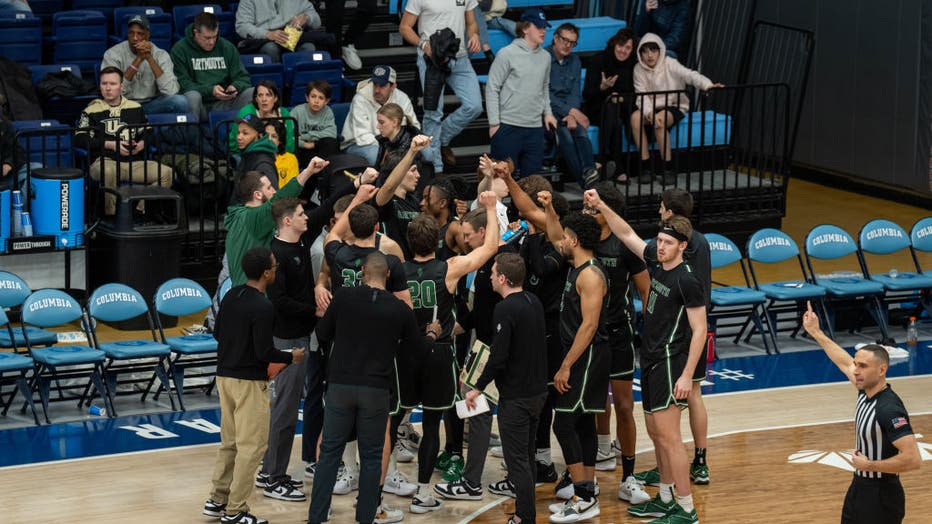Dartmouth University basketball players vote to unionize
NEW YORK, NEW YORK - FEBRUARY 16: Romeo Myrthil #20 (4th-L), Cade Haskins #2 (5th-L) and teammates of the Dartmouth Big Green line up before their game against Columbia Lions in their NCAA mens basketball game on February 16, 2024 in New York City. A
NEW YORK - The Dartmouth men's basketball team voted to unionize Tuesday in an unprecedented step toward forming the first labor union for college athletes and another blow to the NCAA's deteriorating amateur business model.
"We have finally gotten to a point where a team of players put together a case and has gone through with it, has gone forward with it, and is bringing it to the courts to unionize," said John Fanta, FOX sports broadcaster.
The National Labor Relations Board supervised the election where all but 2 players voted to join Service Employees International Union Local 560 which already represents Dartmouth workers.
Dartmouth had told students that unionizing could get the team kicked out of the Ivy League, or even the NCAA. In a statement, the school said it was supportive of the five unions it negotiates with on campus, including SEIU Local 560, but insisted that the players are students, not employees.

NEW YORK, NEW YORK - FEBRUARY 16: Dartmouth Big Green players huddle during their game against Columbia Lions in their NCAA men's basketball game on February 16, 2024 in New York City. After last week's National Labor Relations Board ruling that Dart
"For Ivy League students who are varsity athletes, academics are of primary importance, and athletic pursuit is part of the educational experience," the school said in a statement. "Classifying these students as employees simply because they play basketball is as unprecedented as it is inaccurate. We, therefore, do not believe unionization is appropriate."
"The issue with Dartmouth would be the costs connected with any negotiated agreement. Negotiated agreements are negotiated," said William Herbert, of The National Center for the Study of Collective Bargaining in Higher Education, and the Professions.
Though college athletics has ballooned into a multibillion-dollar industry, the NCAA has maintained its position that players are student-athletes, not employees.
"A lot of people have shaken their heads at the NCAA and said look at how much the association is benefiting and look at how little the student-athlete is benefited," Fanta shared.
THE POTENTIAL IMPACT
A college athletes union would be unprecedented in American sports. A previous attempt to unionize the Northwestern football team failed because opponents in the Big Ten include public schools that aren’t under the jurisdiction of the NLRB.
That is why one of the NCAA’s biggest threats isn’t coming in one of the big-money football programs like Alabama or Michigan, which are largely indistinguishable from professional sports teams. Instead, it is the Ivy League, formed in 1954 by eight academically elite schools in the Northeast, whose players don’t receive athletic scholarships, teams play in sparsely filled gymnasiums and games are streamed online instead of broadcast on network TV.
"These young men will go down as one of the greatest basketball teams in all of history," SEIU international president Mary Kay Henry said. "The Ivy League is where the whole scandalous model of nearly free labor in college sports was born and that is where it is going to die."
Dan Hurley, the coach of the defending national champion UConn men's team, said he believes unionization and treating players as employees is the future of college basketball.
"These players are putting in incredible work days, work weeks for five, six months," he said. "I think there’s so much there that’s going to have to be settled."
Haskins, a 6-foot-6 forward from Minneapolis, is already a member of the SEIU local as a dining hall employee, working 10-15 hours a week on a 10 p.m.-2 a.m. shift to earn spending money; Myrthil, a 6-foot-2 guard from Solna, Sweden, has a part-time job checking people into the gym. They said their top bargaining priority is health insurance so they wouldn't have out-of-pocket costs for their injuries.
"I’m playing a sport I love, and grateful to be doing it," said Haskins, who has had an ankle injury to go with torn labrums in his hip and shoulder. "But it definitely is a burden."
Myrthil and Haskins said they have heard from students at virtually every conference in the country to learn about their unionization efforts. They have said they would like to form an Ivy League Players Association that would include athletes from other sports on campus and other schools in the conference.
They realize, though, that that change could come too late to benefit them and their current teammates: four seniors, five juniors, three sophomores and three freshman.
"We’re confident in the group we have right now. But it depends on how long this goes," Myrthil said. "We’ll see. Next year we’ll get to talk to our freshmen and introduce them to the idea, and what it means. And then hopefully it gets passed on. And I’m pretty confident it will."
With the Associated Press.

